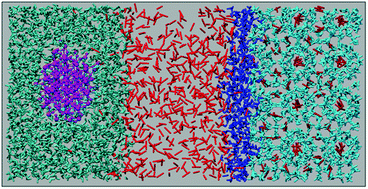The interest in carbon dioxide for enhanced oil recovery is increasing proportional to the decline in naturally driven oil production and also due to the increasing demand for reduced emission of carbon dioxide into the atmosphere. Transport of carbon dioxide in offshore pipelines involves high pressure and low temperatures, conditions which may lead to formation of hydrates from residual water dissolved in carbon dioxide and carbon dioxide. The critical question is whether the water at certain temperatures and pressures will drop out as liquid droplets first, and then form hydrates, or alternatively, adsorb on the pipeline surfaces, and subsequently form hydrates heterogeneously. In this work, we used several different basis sets of density functional theory in ab initio calculations to estimate the charge distribution of hematite (the dominating component of rust) crystals. These rust particles were embedded in water and chemical potential for adsorbed water molecules was estimated through thermodynamic integration and compared to similar estimates for water clusters of the same size. While the generated charges were not unique, the use of high order approximations and different basis sets provides a range of likely charge distributions. Values obtained for the chemical potential of water in different surroundings indicated that it would be thermodynamically favorable for water to adsorb on hematite, and that evaluation of potential carbon dioxide hydrate formation conditions and kinetics should be based on this formation mechanism. Depending on the basis set and approximations, the estimated gain for water to adsorb on the hematite surface rather than condense as droplets varied between −1.7 kJ mole−1 and −3.4 kJ mole−1. The partial charge distribution on the hematite surface is incompatible with the hydrate structure, and thus hydrates will be unable to attach to the surface. The behavior of water outside the immediate vicinity of hematite (beyond 3–4 diameters) closely resembled that of bulk liquid. This indicates that it will be able to form hydrates with readily available carbon dioxide. Thus hematite may still act as adsorption medium in heterogeneous hydrate formation just a few water diameters away from its surface. Theoretical estimates were compared to experimental measurements of water content in carbon dioxide co-existing with liquid water, adsorbed water and hydrate.

You have access to this article
 Please wait while we load your content...
Something went wrong. Try again?
Please wait while we load your content...
Something went wrong. Try again?


 Please wait while we load your content...
Please wait while we load your content...